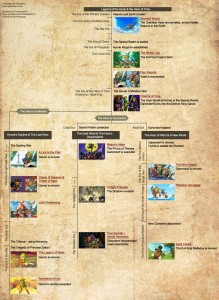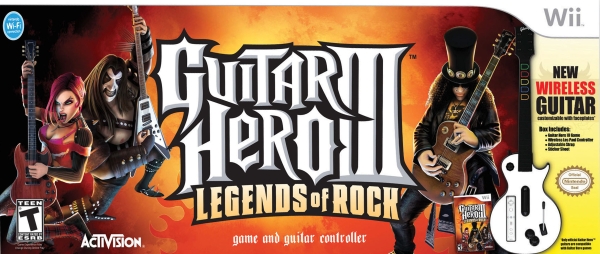Most Recent: Retro
Zelda Producer: Gameplay comes first, where a game fits in timeline is a coincidence
 You didn’t think the arguments over the Legend of Zelda’s official timeline were over did you?
You didn’t think the arguments over the Legend of Zelda’s official timeline were over did you?
After revealing the official timeline to the English-speaking world, GlitterBerri has continued to translate Hyrule Historia on a page-by-page basis. Through her (and her team’s) work, she has discovered that the official timeline is not quite the pre-planned story bible that some fans hoped it would be.
Instead, on page 238, series producer Eiji Aonuma falls back on the traditional Nintendo party line. He confirms that the gameplay hook of a Zelda game is created first and where it fits within the timeline is actually just a coincidence:
Chapter 2, “The Full History of Hyrule,” arranges the series in chronological order so it’s easier to understand, but from the very beginning, Zelda games have been developed with the top priority of focusing on the game mechanics rather than the story. For example, in Ocarina of Time, the first installment of the series I was involved in, the main theme was how to create a game with pleasant controls in a 3D world. Or in the DS game, Phantom Hourglass, the focus was having comfortable stylus controls. Finally, in the most recent game, Skyward Sword, we focused on an easy way to swing the sword using the Wii motion plus.
Thinking of that way of developing the games, it may be correct to say that the story is an appendix to that. I even think that setting Skyward Sword as the “first story,” was merely a coincidence.
So the bottom line is that “The Official Zelda Timeline” is nothing more than an after-the-fact creation used to make Hyrule Historia more enticing to fans. And that’s fine. The timeline as stated still fits together rather elegantly.
But I have to admit, knowing that there was never a plan does put a bit of a damper on the timeline. Especially since Skyward Sword had been billed as the “first story” in the Zelda series since it was announced.
Official Zelda timeline is officially official
 Behold, the official timeline of the Legend of Zelda franchise in all its translated glory (click to enlarge)!
Behold, the official timeline of the Legend of Zelda franchise in all its translated glory (click to enlarge)!
With Hyrule Historia now available in Japan, Zelda translator extraordinaire GlitterBerri has unveiled a more complete English language version of the timelime, confirming the three-way split in the timestream. GlitterBerri also said that longtime Zelda producer Eiji Aonuma is listed as the Supervising Editor of Hyrule Historia, so that’s as close to an official stamp of approval as you can get.
Nintendo obviously isn’t going to stop making new games in the Legend of Zelda franchise anytime soon (in fact, a new Zelda game is in development for the 3DS as we speak), so it’ll be interesting to see where future titles fit into the timeline.
Official Zelda timeline released by Nintendo
 Nintendo has gone all out for The Legend of Zelda’s 25th anniversary. In addition to the concert tour and multiple new game releases, the company has released a commemorative art book in Japan titled Hyrule Historia. Apparently, it also contains an official Zelda timeline sanctioned by Nintendo!
Nintendo has gone all out for The Legend of Zelda’s 25th anniversary. In addition to the concert tour and multiple new game releases, the company has released a commemorative art book in Japan titled Hyrule Historia. Apparently, it also contains an official Zelda timeline sanctioned by Nintendo!
According to a fan translation at Kotaku, the timeline is actually comprised of three parallel universes, all of which are created due to Link’s actions during and after The Legend of Zelda: Ocarina of Time.
Are you ready to think fourth dimensionally?
If Link fails in his quest to defeat Ganon, the events of A Link to the Past come to pass. However, if Link wins the day, the timeline splits in two distinct ways. The Wind Waker branches off from the future timeline where Ganon ruled for seven years while Majora’s Mask follows on from OoT’s ending of Link back in his boyhood village.
So, when its all mapped out, the official timeline looks like this… (more…)
Guitar Hero III tops biggest moneymakers list

Guitar Hero may be dead (for now at least), but the franchise has certainly left its mark on the gaming world. In a report released by The NPD Group yesterday, Guitar Hero III: Legends of Rock was crowned the king of all video games… in terms of total sales dollars that is. The music game has brought $830.9 million into Activision’s coffers, no doubt thanks to the expensive guitar bundle you see above.
Activision can also lay claim to the number two game on the list, Call of Duty: Black Ops (even though gamers have bought more copies of CODBLOPS than any other game ever). All told, the publisher snapped up half of the spots in the top ten.
But when it comes to printing money, the only other name that comes to mind is Nintendo. The consolemaker has four games in the top ten: both versions of Wii Fit, Wii Play and Mario Kart Wii. The only non-Activision/Nintendo title in the top ten was MTV Games’ Rock Band.
Interestingly, no game on the list was released before 2007, but CNBC pointed out that the list may not be entirely accurate as Super Mario Bros. 3 sold 18 million copies back in 1990 (before The NPD Group started tracking game sales). Originally retailing for $50, the game’s $900 million dollar tally would surpass every other game on the list.
Hit the jump for the full top ten. (more…)
Genesis, SNES cartridges compete in endurance competition
Blistered Thumbs hosts the be-all, end-all competition to determine a winner from Sega Genesis and Super Nintendo cartridges in several bouts of toughness. RinryGameGame’s competition used copies of Joe Montana Sports Talk Football (I and II) for the Genesis and the Super Nintendo’s NHL Stanley Cup. Competition events range from being boiled alive to being completely encased in a bowl of Jello. Needless to say, the results are surprising. Watch for yourselves, but first, consider this: can your PlayStation 3, Xbox 360, or Wii games survive this?







